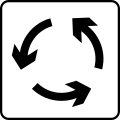
Road signs in Iran are regulated by both INSO standard 14815-1 and 14815-2. [1] [2] They generally follow the Vienna Convention on Road Signs and Signals and their designs both influenced by British and German road signage designs.
Contents
- History
- Warning signs
- Priority signs
- Prohibitive or restrictive signs
- Mandatory signs
- Traffic regulation
- Temporary signs
- Route shields
- References
Road signs are divided in three categories:
- Regulatory signs;
- Warning signs;
- Information signs.






























































































































